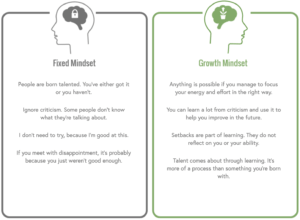Growth mindset is an increasingly popular concept in education, and for good reason. Not only has it been shown to improve student wellbeing, but a recent PISA report highlights that students with a growth mindset also performed better in reading, science and maths than their peers who demonstrated a fixed mindset. But how do you foster a growth mindset in your students?
Growth mindset vs fixed mindset
The concept of a growth mindset was developed by Carol Dweck who is a Lewis and Virginia Eaton Professor of Psychology at Stanford University. She has won many awards for her research and is widely recognised as a thought leader in the space. In her book ‘Mindset’ she explores the power of our mindset, in particular the concepts of the growth and fixed mindset.
As summarised by Carol Dweck “Individuals who believe their talents can be developed (through hard work, good strategies, and input from others) have a growth mindset. They tend to achieve more than those with a more fixed mindset (those who believe their talents are innate gifts).”
The concept explores the way in which our perception of ourselves and our abilities impact our performance. If you think that improvement is impossible, you will not strive to correct your mistakes and will not be able to develop. However, if you understand that practice is the key to improvement you will be able to work on your skills.
Carol Dweck talks about the ‘Power of Yet’ in her TED talk. In it, she explains that by students believing they’ve not achieved their goals yet, they imply to themselves that the task is possible and with more practice they’ll be able to achieve it.
What it means in practice
Despite the obvious merit of a growth mindset sometimes it might be difficult to know how to put it into practice. Here are some things you can do to foster a growth mindset in your students.
Refrain from focusing on intelligence
During a Talk at Google Carol Dweck said “Our research shows telling people they’re smart actually backfires. It makes them afraid of challenges, it makes them fold in the face of obstacles, because they’re worried ‘Oh does this not look smart?’, ‘Am I not smart?’”. By praising intelligence in this way, we might enforce the idea that it is an inherent trait and therefore cannot be developed with time and hard work. This is counterproductive to developing a growth mindset, so instead praise the outcomes and the effort students put in.
Set achievable goals
Setting goals helps us focus our efforts and is a great way to help students in tracking their progress. The goals can fall into short- and long-term categories but should build upon each other and help students overcome their ultimate challenges. At EtonX we encourage students to set SMART goals to help them continue learning even after the course ends.
Challenge your students
A big part of developing a growth mindset is moving away from seeing challenges as something negative. Encourage your students to get out of their comfort zone and do something they find challenging. This could be singing up for a sports club, starring in a school play or volunteering. Don’t impose your ideas onto the students but rather encourage them to explore what they view as a challenge.
Treat mistakes as learning opportunities
Reframing mistakes is crucial to developing a growth mindset. It’s not about brushing the mistakes off or giving them platitudes, but rather taking the experience and seeing it as a learning opportunity. Ask your students to reflect on what they could’ve done better, why they made the mistake and help them set out a plan on how they’ll avoid making that mistake in the future.
Encourage them to reflect
Reflection is a crucial part of developing a growth mindset, as Carol Dweck writes “we all have our own fixed-mindset triggers. When we face challenges, receive criticism, or fare poorly compared with others, we can easily fall into insecurity or defensiveness, a response that inhibits growth.”. These triggers can cause students to fall back into negative behaviour and thought patterns. By reflecting on situations in which they encounter failure and examining how it made them feel they can stay ‘in the growth zone’.
One way in which students can reflect is examining their thought patterns and emotions which come up when facing challenges. The image below can help them understand how growth and fixed mindsets manifest in every day thinking.

Content from the EtonX Resilience Course
Embrace the ‘yet’
As Carol Dweck explained there is a power in using the word ‘yet’. Changing ‘I am not good at maths’ to ‘I am not good at maths yet’ will help students understand that their skills are always developing and they have the power to improve.
The growth mindset is not something which is developed easily and is not always a linear progression. However, by challenging your students to reframe their way of viewing failure and challenges you will equip them with a powerful tool for growth.
We further explore the idea of dealing with failure and developing a growth mindset in our Resilience course, which you can check out here.
